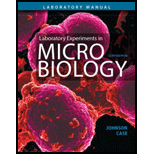
Concept explainers
To write:
The effectiveness of autoclaving, boiling, microwaving and dry heating.
Introduction:
Sterilization is the killing or removal of all the living microorganisms, including the bacterial spores that are highly resistant. It is usually carried out by autoclaving or moist heating, boiling, microwaving and dry heating as the effective methods and consists of maximum exposure to steam as well.
Explanation of Solution
Autoclaving is a moist heat sterilization method that uses high-pressure steam. This process works by the concept that the boiling point of water or steam increases when it is under pressure. The steam inside the autoclave attacks the microorganisms and kills them. Boiling is a simple method of heating water to a high temperature of 100°C, kills most of the pathogenic microorganisms.
Microwaving is a thermal process and most of the processed foods are heat treated to kill the microorganisms. It does not kill the microorganisms completely. Dry heating kills or removes all the microorganisms, including bacterial spores. It requires a longer time for exposure as well as higher temperatures as well. Its higher temperature kills the microorganisms using a destructive oxidation method. Moist heating or autoclaving is the most effective way of killing all the microorganisms, because of its ability to penetrate microbial cells. It is followed by dry heating and then, boiling is effective as it produces heat more thoroughly and flashover can be avoided as compared to microwaving.
Thus, the effectiveness of moist heating or autoclaving is the highest, followed by dry heating that requires longer time and the temperature, then boiling with temperature of 100°C and lastly, microwaving which is a thermal process.
Want to see more full solutions like this?
Chapter 22 Solutions
Laboratory Experiments in Microbiology (12th Edition) (What's New in Microbiology)
- Using pasteurization techniques as a model, compare the TDTs and explain the relationships between temperature and length of exposure.arrow_forwardDefine moist and dry heat, and explain their modes of action andrelative effectiveness.arrow_forwardHow can a life cycle of microorganism and heat resistance graph be used to determine the boiling time and temperature of heat treatment?arrow_forward
- Differentiate between thermal death point and thermal death time,and provide examples of their uses.arrow_forwardDescribe how foods are lyophilized and compare the advantages and disadvantages and effects of lyophilization on the product compared to other drying methods?arrow_forwardDistinguish heat sterilization and "commercial sterility".arrow_forward
- Compare and contrast moist and dry heat methods of microbe control and give 2 examples of each.arrow_forwardBetween moist heat, dry heat, cold, desiccation, radiation and filter. How would you rank the best method to the least method in fighting microbes?arrow_forwardList the five categories of optimum temperature and describe a corresponding environment in which a representative might thrive?arrow_forward
- Choose the combination of answers that most accurately completes the statement. The most versatile method of sterilizing heat-sensitive liquids is a. UV radiation c. beta propiolactone b. exposure to ozone d. fi ltrationarrow_forwardChoose the combination of answers that most accurately completes the statement.The most versatile method of sterilizing heat-sensitive liquids is a. UV radiation c. beta propiolactone b. exposure to ozone d. fi ltrationarrow_forwardWhat is an alternative to autoclaving for sterilizing heat-sensitive materials?arrow_forward
 Human Anatomy & Physiology (11th Edition)BiologyISBN:9780134580999Author:Elaine N. Marieb, Katja N. HoehnPublisher:PEARSON
Human Anatomy & Physiology (11th Edition)BiologyISBN:9780134580999Author:Elaine N. Marieb, Katja N. HoehnPublisher:PEARSON Biology 2eBiologyISBN:9781947172517Author:Matthew Douglas, Jung Choi, Mary Ann ClarkPublisher:OpenStax
Biology 2eBiologyISBN:9781947172517Author:Matthew Douglas, Jung Choi, Mary Ann ClarkPublisher:OpenStax Anatomy & PhysiologyBiologyISBN:9781259398629Author:McKinley, Michael P., O'loughlin, Valerie Dean, Bidle, Theresa StouterPublisher:Mcgraw Hill Education,
Anatomy & PhysiologyBiologyISBN:9781259398629Author:McKinley, Michael P., O'loughlin, Valerie Dean, Bidle, Theresa StouterPublisher:Mcgraw Hill Education, Molecular Biology of the Cell (Sixth Edition)BiologyISBN:9780815344322Author:Bruce Alberts, Alexander D. Johnson, Julian Lewis, David Morgan, Martin Raff, Keith Roberts, Peter WalterPublisher:W. W. Norton & Company
Molecular Biology of the Cell (Sixth Edition)BiologyISBN:9780815344322Author:Bruce Alberts, Alexander D. Johnson, Julian Lewis, David Morgan, Martin Raff, Keith Roberts, Peter WalterPublisher:W. W. Norton & Company Laboratory Manual For Human Anatomy & PhysiologyBiologyISBN:9781260159363Author:Martin, Terry R., Prentice-craver, CynthiaPublisher:McGraw-Hill Publishing Co.
Laboratory Manual For Human Anatomy & PhysiologyBiologyISBN:9781260159363Author:Martin, Terry R., Prentice-craver, CynthiaPublisher:McGraw-Hill Publishing Co. Inquiry Into Life (16th Edition)BiologyISBN:9781260231700Author:Sylvia S. Mader, Michael WindelspechtPublisher:McGraw Hill Education
Inquiry Into Life (16th Edition)BiologyISBN:9781260231700Author:Sylvia S. Mader, Michael WindelspechtPublisher:McGraw Hill Education





